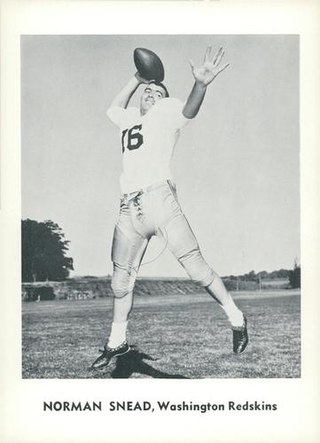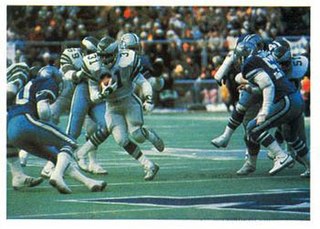A draft is a process used in some countries and sports to allocate certain players to teams. In a draft, teams take turns selecting from a pool of eligible players. When a team selects a player, the team receives exclusive rights to sign that player to a contract, and no other team in the league may sign the player. The process is similar to round-robin item allocation.

The NFL draft, officially known as the Annual Player Selection Meeting, is an annual event which serves as the most common source of player recruitment in the National Football League. Each team is given a position in the drafting order in reverse order relative to its record in the previous year, which means that the last place team is positioned first and the Super Bowl champion is last. From this position, the team can either select a player or trade its position to another team for other draft positions, a player or players, or any combination thereof. The round is complete when each team has either selected a player or traded its position in the draft. The first draft was held in 1936 and has been held every year since.

The 1966 NFL season was the 47th regular season of the National Football League, and the first season in which the Super Bowl was played, though it was called the AFL-NFL World Championship Game. The league expanded to 15 teams with the addition of the Atlanta Falcons, making a bye necessary one week for each team.

The 1961 NFL season was the 42nd regular season of the National Football League (NFL). The league expanded to 14 teams with the addition of the Minnesota Vikings, after the team's founders declined to be charter members of the new American Football League. The schedule was also expanded from 12 games per team to 14 games per team where it would stay for 17 years. The Vikings were placed in the Western Division, and the Dallas Cowboys were switched from the Western Division to the Eastern Division. The addition of the Vikings returned the NFL to an even number of teams.
The 1960 NFL season was the 41st regular season of the National Football League.

Norman Bailey Snead was an American professional football player who was a quarterback in the National Football League (NFL). He played for the Washington Redskins, Philadelphia Eagles, Minnesota Vikings, New York Giants, and San Francisco 49ers. He played college football for the Wake Forest Demon Deacons and was the second overall selection of the 1961 NFL draft.
The 1961 NFL draft took place at the Warwick Hotel in Philadelphia on December 27–28, 1960. The league would later hold an expansion draft for the Minnesota Vikings expansion franchise. This draft was also the first regular draft for the Dallas Cowboys as they had only participated in the 1960 NFL expansion draft that year.
During the first seven years of existence (1960–1966) of the American Football League, the AFL and the NFL held separate, competing drafts for college football talent.

The 1980 Philadelphia Eagles season was the team's 48th season in the National Football League (NFL). The Eagles won twelve of their sixteen games, winning their division for the first time in twenty years. The Eagles started the season winning eleven of their first twelve games, only to finish the season losing three of their final four. Still, the 12–4 record was good enough to win the NFC East division title for the first time in franchise history since the NFC East had been formed.

The 1979 Philadelphia Eagles season was the franchise's 47th season in the National Football League (NFL).
The 1960 Philadelphia Eagles season was the franchise's 28th season in the National Football League, and finished with the Eagles' win over the Green Bay Packers in the NFL championship game to get their third league title. The victory over the Packers was also the first and only playoff defeat of the Packers' Vince Lombardi's coaching career. The 1960 season was the Eagles' first postseason appearance since their last NFL championship season of 1949. It was their only postseason appearance in the 28 seasons from 1950 to 1977, and their last NFL title until their victory in Super Bowl LII, 57 years later.
The 1964 Philadelphia Eagles season was the franchise's thirty-second season in the National Football League.
The 1965 Philadelphia Eagles season was the franchise's thirty-third season in the National Football League.
The 1966 Philadelphia Eagles season was the franchise's 34th season in the National Football League.

The 1995 Philadelphia Eagles season was their 63rd in the National Football League (NFL). The team improved upon their previous output of 7–9, going 10–6 under new head coach Ray Rhodes and qualifying for the playoffs for the first time in three seasons. They would lose to the Cowboys in the Divisional round, the second time in four years.
The 1984 Philadelphia Eagles season was their 52nd in the National Football League (NFL). The team improved upon their previous output of 5–11, winning six games. Despite the improvement, the team failed to qualify for the playoffs for the third straight season.
The 1959 Philadelphia Eagles season was the franchise's 27th season in the National Football League. They improved on their previous output of 2–9–1, winning seven games. The team failed to qualify for the playoffs for the tenth consecutive season.
The 1955 Philadelphia Eagles season was their 23rd in the league. They failed to improve on their previous output of 7–4–1, winning only four games. The team failed to qualify for the playoffs for the sixth consecutive season. 1955 marked the end of an era, as the last remaining Phil-Pitt Steagle, longtime player Bucko Kilroy, retired after 13 seasons in the NFL, all of them with the Eagles, going back to when they were known as the Steagles.
The 1950 Philadelphia Eagles season was their 18th in the league. The team failed to improve on their previous output of 11–1, winning only six games. The team failed to qualify for the playoffs for the first time in four seasons.
The 1945 Philadelphia Eagles season was the Eagles' 13th in the league. The team failed to improve on its previous output of 7–1–2, losing three games.







